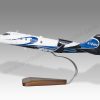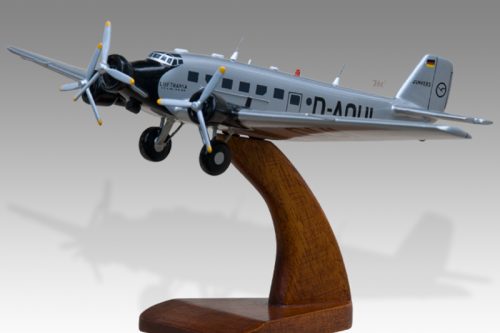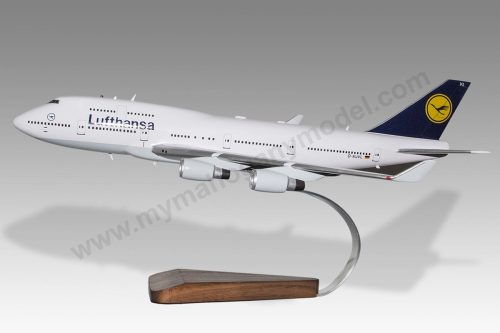Airbus A300 Lufthansa
Production Time 9 to 10 weeks
Shipment is by FedEx, UPS or DHL International Express Courier with a normal door-to-door delivery time worldwide of within 2-3 business days after dispatch. Due to the current volatility of world fuel prices, the amount mentioned here is our best estimate for DHL and UPS and may be subject to change at the time of shipping.

Model Description: Airbus A300 Lufthansa Wood Replica Scale Custom Model Aircraft
Manufacturer: Airbus Industries
Product Statistics
Length: 17 Inches (43.2 Centimeters)Wingspan: 14.1 Inches (35.8 Centimeters)
Height: 5.2 Inches (13.2 Centimeters)
Scale: 1:125
Registration: D-AIAF
$239.50
Production Time 9 to 10 weeks
-
United States dollar ($)
-
Pound sterling (£)
-
Euro (€)
-
Australian dollar ($)
-
Canadian dollar ($)
-
Singapore dollar ($)
-
Swiss franc (CHF)
-
Japanese yen (¥)
-
Danish krone (kr.)
-
Hong Kong dollar ($)
-
Norwegian krone (kr)
-
Swedish krona (kr)
General Product Description
Our MyMahoganyModel Airbus A300 Lufthansa exhibits unique, unrivaled quality and detailed design to come as close as possible to the accuracy of the actual plane. It comes as standard with a robust, durable base or stand which is available in a variety of different finishes designed to match your own personal requirements including solid wood, wood with polished metal supports or adjustable wood wall mount and will be ready within about 9-10 weeks from placement of order.
The Airbus A300 Lufthansa is made of the finest kiln dried renewable mahogany wood (commonly known as Lauan or Meranti) which has undergone many stages of carving and meticulous and careful sanding giving the beautiful finished museum quality masterpiece. Many collectors and model connoisseurs demonstrate their preference for genuine handmade and hand painted mahogany wood models rather than plastic or die cast (diecast) alternatives due to the overall look and totally different feel of the item - we trust you will find the same. We can, however, if required produce the same model in Solid Cast Resin so just click and contact us us for further information. Our craftsmen and gifted artisans ensure that our finely handcrafted model airplanes match the precise blueprint details of the original aircraft. The paint scheme, markings and parts are closely matched, reflecting the original aircraft. This stylish top-quality desktop replica model will surely enthrall anyone who receives this as a gift and for sure one of the most appropriate and desirably collectable gifts for any aviation enthusiast and avid aircraft collector whilst also displaying a perfect resemblance to the actual aircraft.
If you require we can also make the Airbus A300 Lufthansa in any other airline, private livery or colour scheme you require and if necessary in a different size or scale. Just click here to contact us with a description or photographs of what you require, and we will let you have a quotation for the necessary customization by return email. We can also make bespoke scale replicas of any other private / civil commercial airliner or airliners, helicopter, glider, gliders with engines, military jet, warplane jets, propeller warplanes, biplane, triplane, tail fin, spacecraft, rocket or NASA model you require in any airline, military or civilian livery or colors. We also produce model airships, blimp, dirigible, blimps, boat and ship collectibles. Wall plaque or seal for military, government or private customers. Again, by clicking here to contact us just let us know exactly what you need.
The Airbus A300: Lufthansa’s Pioneering Workhorse in the Skies
In the dynamic world of aviation, certain aircraft leave an indelible mark on the industry, and the Airbus A300 is undoubtedly one of them. This wide-body, twin-engine jetliner has played a pivotal role in shaping the commercial aviation landscape since its introduction. Among the many airlines that embraced this technological marvel, Lufthansa, the German flag carrier, stands out as a key operator of the Airbus A300, contributing to its success and reputation as a reliable workhorse in the skies.
A Brief History of the Airbus A300:
The Airbus A300, the first twin-engine wide-body jetliner, made its maiden flight in 1972. Jointly developed by French and German aerospace manufacturers, Aérospatiale and Deutsche Airbus, the A300 aimed to fill the gap between smaller narrow-body aircraft and larger, four-engine wide-body jets. Its innovative design incorporated a wide fuselage, leading to increased passenger capacity, fuel efficiency, and reduced operating costs.
Lufthansa’s Adoption of the Airbus A300:
Lufthansa was one of the launch customers of the Airbus A300, placing its first order in 1970. The German airline recognized the potential of this groundbreaking aircraft and became the first airline to put the A300 into commercial service in 1974. Lufthansa’s commitment to the A300 marked a significant milestone for both the airline and the aircraft manufacturer, solidifying the A300’s reputation as a versatile and reliable choice for long-haul flights.
Technical Features:
The Airbus A300 boasted several technical innovations that set it apart from its contemporaries. The aircraft’s twin-engine configuration, combined with advanced aerodynamics, allowed for improved fuel efficiency and operational flexibility. Its wide fuselage allowed for a spacious and comfortable cabin layout, making it popular among passengers and airlines alike.
Lufthansa configured its A300s with a two-class seating arrangement, accommodating around 266 passengers in a typical layout. This configuration made the aircraft ideal for medium to long-haul routes, and Lufthansa successfully utilized the A300 on various international and domestic routes.
Operational Performance:
The Airbus A300 became a cornerstone of Lufthansa’s fleet, contributing significantly to the airline’s operational success. The aircraft’s ability to cover long distances with cost-effective fuel consumption made it an economic choice for transatlantic flights and other high-demand routes. Lufthansa’s A300 fleet became synonymous with efficiency, reliability, and passenger comfort.
Legacy and Evolution:
As the aviation industry evolved, newer and more advanced aircraft entered the market. The Airbus A300 gradually transitioned from commercial service to secondary roles, such as cargo transport and charter flights. Lufthansa retired its last A300 in 2009, marking the end of an era for the airline and the aircraft that played a crucial role in its history.
Despite its retirement from passenger service, the Airbus A300’s legacy lives on in the annals of aviation history. Its pioneering design, efficient operation, and the partnership between Lufthansa and Airbus continue to influence the development of modern aircraft.
Conclusion:
The Airbus A300 holds a special place in the hearts of aviation enthusiasts, and Lufthansa’s early adoption and extensive use of this groundbreaking aircraft played a vital role in its success. As the aviation industry continues to evolve, the legacy of the Airbus A300 and its impact on commercial air travel remain a testament to the collaborative efforts of airlines and manufacturers in pushing the boundaries of innovation in the sky.
| Weight | 6 kg |
|---|---|
| Dimensions | 17 × 14.1 × 5.2 in |
Be the first to review “Airbus A300 Lufthansa” Cancel reply
Similar Models
Private & Civilian
Private & Civilian
Private & Civilian
Private & Civilian
Private & Civilian
Private & Civilian
Private & Civilian
Private & Civilian
Private & Civilian
Private & Civilian
Private & Civilian
Private & Civilian
Private & Civilian
Private & Civilian
Private & Civilian
Private & Civilian
Private & Civilian
Private & Civilian
Space, NASA & Experimental
Private & Civilian
Private & Civilian
Private & Civilian
Private & Civilian


































Reviews
There are no reviews yet.